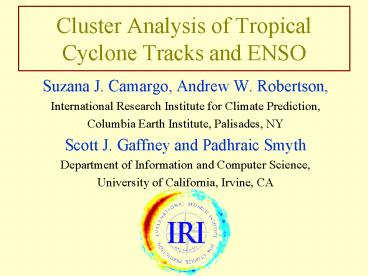Cluster Analysis of Tropical Cyclone Tracks and ENSO - PowerPoint PPT Presentation
1 / 36
Title:
Cluster Analysis of Tropical Cyclone Tracks and ENSO
Description:
Department of Information and Computer Science, University of California, Irvine, CA ... New clustering technique applied to Northern Hemisphere TC tracks. ... – PowerPoint PPT presentation
Number of Views:27
Avg rating:3.0/5.0
Title: Cluster Analysis of Tropical Cyclone Tracks and ENSO
1
Cluster Analysis of Tropical Cyclone Tracks and
ENSO
- Suzana J. Camargo, Andrew W. Robertson,
- International Research Institute for Climate
Prediction, - Columbia Earth Institute, Palisades, NY
- Scott J. Gaffney and Padhraic Smyth
- Department of Information and Computer Science,
- University of California, Irvine, CA
2
Outline
- Introduction
- Clustering Technique
- Previous works on cluster analysis and tropical
cyclones - Western North Pacific Results
- Mean Regression Trajectories
- Tracks
- Properties of main clusters
- ENSO Relationship tracks, tracks density, NTC,
ACE - Composites SST, SLP, winds, wind shear
- North Atlantic Results
- Mean Regression Trajectories and Tracks
- ENSO relationship
- Atlantic multi-decadal signal
- Eastern North Pacific Results
- Mean Regression Trajectories and Tracks
- ENSO relationship
- Summary
3
Introduction
- Identify different track types, their seasonality
and relation with large-scale circulation and
ENSO. - Importance different track types have higher
incidence on some years and make landfall in
different regions. - New clustering technique used.
- Best track datasets
- Western North Pacific JTWC 1950-2002.
- North Atlantic NHC 1851-2003.
- Eastern North Pacific NHC 1949-2003.
- Only tropical cyclones (TCs) with tropical storm
or hurricane (typhoon) intensity (no tropical
depressions).
4
Clustering Technique
- Developed by S.J. Gaffney and P. Smyth
- - S.J. Gaffney (2004), Ph.D. thesis, University
of California, Irvine. - Mixture of polynomial regression models (curves)
to fit the geographical shape of the
trajectories. - Extension of the standard multivariate finite
mixture model to allow quadratic functions. - Enable highly non-Gaussian density functions to
be expressed as a mixture of a few PDFs. - Fitting by maximizing the likelihood of the
parameters. - Rigorous probabilistic context for clustering
- Accommodate easily tropical cyclone tracks of
different lengths.
5
Previous works on Cluster Analysis and Tropical
Cyclones
- Western North Pacific
- P.A. Harr and R.L. Elsberry, Mon. Wea. Rev. 123,
1225-1246 (1985). - J.B. Elsner and K.B. Liu, Climate Research 25,
43-54 (2003) - North Atlantic
- J.B. Elsner, Bull. Amer. Meteor. Soc. 84, 353-356
(2003) J.B. Elsner et al., J. Climate 13,
2293-2305 (2000). - Eastern North Pacific (TC precursors)
- J.B. Mozer and J.A. Zehnder, J. Geophys. Res.
Atmos. 99, 8085-8093 (1994).
6
Western North Pacific Tropical Cyclones Cluster
AnalysisResults
7
Mean Regression Trajectories
- Appropriate number of clusters appears to be
seven. - Quantitative (out of sample likelihood) and
subjective analysis. - Two main trajectory-types straight-movers and
recurvers. - Additional clusters detailed differences in
shape among these types.
8
TRACKS TROPICAL CYCLONES Western North Pacific
1983-2002
TRACKS
MEAN REGRESSION TRAJECTORIES
9
Number of TCs per Cluster
10
Cluster A
TRACK DENSITY
FIRST POSITION DENSITY
NTC ANNUAL CYCLE
Landfall 63
Regression Trajectory
- 67 reach typhoon intensity
11
Cluster B
TRACK DENSITY
FIRST POSITION DENSITY
NTC ANNUAL CYCLE
Landfall 61
Regression Trajectory
50 only reach TS intensity.
12
Cluster C
TRACK DENSITY
FIRST POSITION DENSITY
NTC ANNUAL CYCLE
Landfall 7
Regression Trajectory
- 70 reach typhoon intensity
13
ENSO Relationship
NTC- Number of Tropical Cyclones
ACE Accumulated Cyclone Energy
Total ACE has a well known relationship with ENSO
(Camargo Sobel, 2004).
Total NTC per year is not significantly correlated
with ENSO (e.g. Wang Chan, 2002).
14
Tracks El Niño years
Tracks La Niña years
Cluster A
Cluster E
Cluster G
15
Track Density per year Difference El Niño and La
Niña years
Full basin
Cluster A
Cluster G
Cluster E
16
Mean NTC and ACE per cluster and ENSO
A
E
G
A
G
E
17
SST Anomalies Composites
TCs first positions
SST and TC data for SST composites11/81 12/02
Regression trajectory
18
Sea Level Pressure Anomalies Composites
NCEP Reanalysis and TC data for composites
1950-2002
19
Anomalous Low Level Wind Composites
20
Wind Shear Composites
Magnitude of the total wind shear between 200hPa
and 850hPa
21
North Atlantic Tropical Cyclones Cluster
AnalysisResults
22
Tracks and Regression Trajectories
Mean Regression Trajectory
TRACKS
Tracks Atlantic named Tropical Cyclones 1970-2003.
23
Number of TCs per cluster
24
ENSO Relationship
NTC correlations
ACE correlations
25
Tracks El Niño years
Tracks La Niña years
Cluster 1
Cluster 2
Cluster 3
Named Tropical Cyclones in warm/cold ENSO years
1950-2003
26
Named Tropical Cyclones 1950-2003
27
SST Anomalies Composites
Main Development Region
SST and TC data for SST composites 11/81
12/2003
TCs First Positions
28
Wind shear composites
NCEP Reanalysis and TC data for composites
1950-2003.
Magnitude of the total wind shear between 200hPa
and 850hPa.
29
Atlantic Multi-Decadal Signal
- S.B. Goldenberg, C.W. Landsea, A.M. Mesta-Nuñez
and W.M. Gray, Science 293, - 474-478 (2001).
30
Number of Major Hurricanes per cluster
31
SST anomalies composite
SST composites 11/1981-12/2003
32
Eastern North PacificTropical CyclonesCluster
Analysis Results
33
Mean Regression Trajectories and Tracks
34
ENSO Relationship
35
Tracks El Niño years
Tracks La Niña years
Cluster 1
Cluster 2
Cluster 3
36
Summary
- New clustering technique applied to Northern
Hemisphere TC tracks. - Clusters with different properties genesis and
track regions, intensity, timing. - In all basins clusters strongly related to ENSO
are identified. - Composites of large scale fields with different
characteristics for each cluster identify the
factors influencing the formation and movement of
TCs in each cluster.































